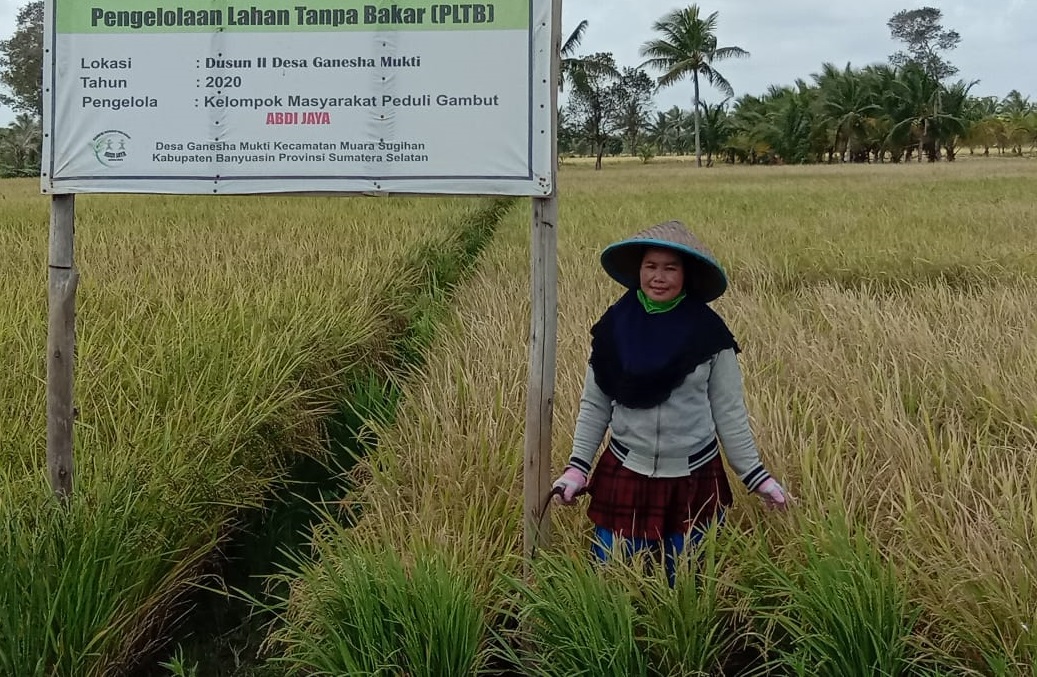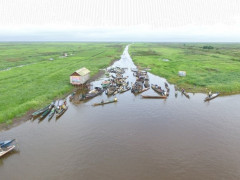The Lives of “Water People” in South Kalimantan
By Simpul Jaringan Kalsel
Farmers' Dilemma When South Sumatra Becomes the Target for Food Estate Project
Robani said that farmers’ problems are not only related to the availability of production tools and agricultural land but also land cultivation up to post-harvest management. Farmers are distraught because the government programs tend to miss the real problems. "Let's say they provide superior seeds but on the other hand, the fertilizer is expensive," he said. It is also difficult for farmers to get fertilizer subsidies.
He added that the selling price of grain and rice tends to drop during the harvest period so that it does not worth the production costs. "Sometimes what we get from selling the harvest is less than the production costs," said Robani.
When the solution to improve the farmers’ fate and independence with their yields is still unclear, the government has already come up with a national food estate project. Farmers welcome the new project without knowing its details.
Even without a national food estate project, farmers have tried to develop a similar project, such as the one in Ganesha Mukti Village. “Residents buy rice from the farmers so that farmers no longer need to use their land as loan collateral," said Tuwon, Head of Ganesha Mukti Village. The loan is used as capital to cultivate their land during the new planting season.

Ganesha Mukti Village covers an area of 24 square kilometers. The rice field covers an area of 1,200 hectares and the remaining land is planted with coconut trees and areca palms. Ganesha Mukti Village has quite a promising agricultural potential for the welfare of farmers. "Farmers try to plant rice twice a year," he said. This is to boost the economy of local farmers in Ganesha Mukti Village.
Data from the South Sumatra Office of Agriculture, Food Crops, and Horticulture shows that the food estate project targets seven districts. The size of land to be used for food estate is different in each district. 118,732 hectares will be used for food estate in Banyuasin, 59,751 hectares in Ogan Komering Ilir, 20,000 hectares in Musi Banyuasin, 10,000 hectares in Ogan Ilir, 50,000 hectares in Ogan Komering Ulu Timur, and 10,000 hectares each in Musi Rawas and Muara Enim.
"Food estates are developed on existing and new lands," said the Acting Head of the South Sumatra Office of Agriculture, Food Crops, and Horticulture, Bambang Pramono. The areas burned during the fire disaster can be utilized as new lands for food estate.
The food estate project has started this year when the Minister of Agriculture, Syahrul Yasin Limpo, launched the project in South Sumatra on 28 May 2021. After the launching, there have been no further details on the process, except that the land will be prepared and the central government will determine the coordinates of Area of Interest (AOI) for the food estate program through One Map Policy Acceleration (PKSP). However, until now there has been no detailed information on the location of lands to be used for food estate.
Bambang explained that the development will continue with a production target of five million tons of dry milled unhulled rice in 2022. He added that the Government of South Sumatra is trying to create a corporate-based food estate by assisting the cultivation of agricultural commodities.
"The assistance depends on the location and farmers' needs from upstream to downstream," he said. This is to increase farmers’ independence.
In 2019, the Center for Agricultural Land Resources (BBSDLP) reported that five districts have peatlands in their area, i.e. 151,703.81 hectares in Banyuasin, 640,134.07 hectares in Ogan Komering Ilir, 237,749.06 hectares in Musi Banyuasin, 37,969.09 hectares in Musi Rawas, 21,930.14 hectares in Muara Enim. And there are no peatlands in Ogan Ilir and Ogan Komering Ulu Timur.
Farmers need cooperatives
Food production in the food estate program raises some concerns because it involves corporates. Director of the Spora Institute, Julian Junaidi Polong, thinks that the government has not completely empowered farmers to become self-sufficient. "They do not balance it by strengthening the farmers’ institutions," he said.
In South Sumatra, the government has not touched on the institutional issue. Julian emphasized that farmers' institutions are not corporations, but cooperatives. Farmers do not get to enjoy it when agricultural production increases, but other groups do. "Only the middlemen, rice mills, and companies that market the rice to consumers get to enjoy the benefits," he said.
Julian observed that farmers are only used as a tool in the agricultural production process. Corporations tend to control the availability of seeds, fertilizers, pesticides, and agricultural equipment. Corporations also control the post-harvest process. Everything that is controlled by the corporation gets the most added value, while most risks are borne by the farmers in the production process. Thus, the role of corporations in food estates only adds to the complexity of farmers' efforts to achieve prosperity.
"Our food agriculture style is heavily affected by cultural issues," said Julian, who is also an academic at the Faculty of Agriculture, Sriwijaya University. Large-scale agriculture as a state project to meet food needs is considered unsuitable for farmers' welfare.
Farmers are not laborers
Regional Coordinator of the South Sumatra Agrarian Reform Consortium, Untung Saputra, said that without the food estate project, Ogan Komering Ilir, Ogan Komering Ulu Timur, Musi Rawas, and Musi Banyuasin districts already function as food estates. Food estates pose a risk of marginalizing farmers from their own land. "Don't treat farmers as laborers on their own land," he said.
He observed that food estate is not just about meeting food needs. It is also prone to causing problems. "To achieve food security, farmers are the ones who should get the access to lands, not corporations," he said.
Untung also highlighted the issue of technology in the food estate project. The provision of agricultural supporting technology should not only be for the benefit of the food estate. The government should also provide supporting infrastructure for independent farmers. "The state should facilitate the people. Farmers’ productivity must be adjusted to the local needs and culture," he said.
The food estate’s trading system is also risky. "Prices are still uncertain," he said.
Author : Ibrahim Arsyad
Editor : Bram Setiawan



